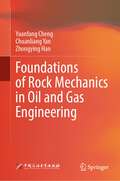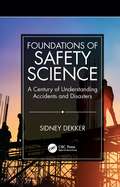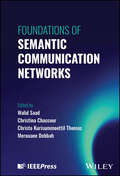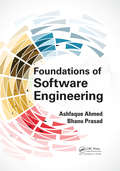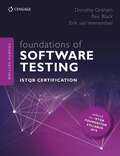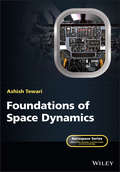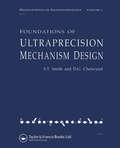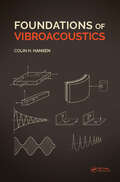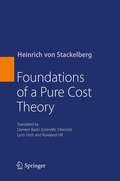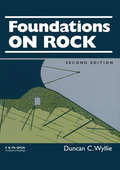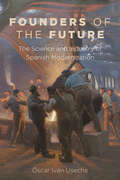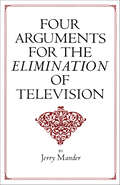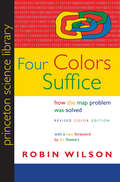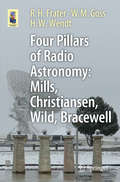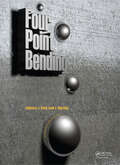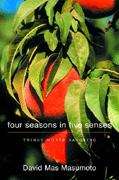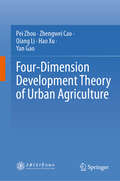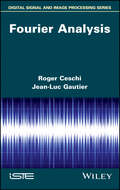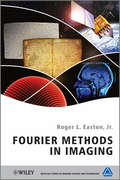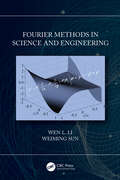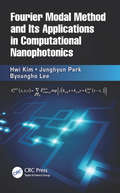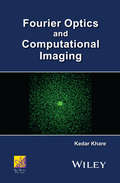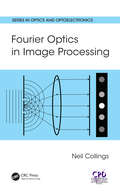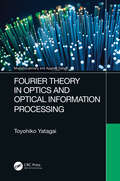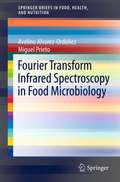- Table View
- List View
Foundations of Rock Mechanics in Oil and Gas Engineering
by Yuanfang Cheng Chuanliang Yan Zhongying HanThis book introduces the basic theoretical knowledge of rock mechanics and its application in petroleum engineering. It covers the gamut of the formulas and calculations for petroleum engineers that have been compiled over decades, while others are meant to help guide the engineer through some of the more recent breakthroughs in the industry’s technology.The topics are introduced at a level that should give a good basic understanding of the subject:• Basic concepts of stress and strain• Experimental method of rock mechanics• Rock deformation and strength characteristics• Rock strength failure criterion• In situ stress state• Application method of rock mechanics theory in the field of wellbore stability• Application method of rock mechanics theory in the field of sand production• Application method of rock mechanics theory in the field of hydraulic fracturing.This textbook contains abundant figures, illustrations, and tables, providing valuable examples and exercises.Key Features and Benefits for the Reader: • Helps in understanding the basic concepts of rock mechanics• Applies rock mechanics theory and method to various fields of petroleum engineering• Includes a large number of calculations, tables, and equations that are very useful for petroleum engineers• Presents new and updated sections in rock mechanics of petroleum engineering.
Foundations of Safety Science: A Century of Understanding Accidents and Disasters
by Sidney DekkerHow are today’s ‘hearts and minds’ programs linked to a late-19th century definition of human factors as people’s moral and mental deficits? What do Heinrich’s ‘unsafe acts’ from the 1930’s have in common with the Swiss cheese model of the early 1990’s? Why was the reinvention of human factors in the 1940’s such an important event in the development of safety thinking? What makes many of our current systems so complex and impervious to Tayloristic safety interventions? ‘Foundations of Safety Science’ covers the origins of major schools of safety thinking, and traces the heritage and interlinkages of the ideas that make up safety science today. Features Offers a comprehensive overview of the theoretical foundations of safety science Provides balanced treatment of approaches since the early 20th century, showing interlinkages and cross-connections Includes an overview and key points at the beginning of each chapter and study questions at the end to support teaching use Uses an accessible style, using technical language where necessary Concentrates on the philosophical and historical traditions and assumptions that underlie all safety approaches
Foundations of Semantic Communication Networks
by Walid Saad Christina Chaccour Christo Kurisummoottil Thomas Merouane DebbahComprehensive overview of the principles, theories, and techniques needed to build end-to-end semantic communication systems, with case studies included. In this rapidly evolving landscape, the integration of connected intelligence applications highlights the pressing need for networks to gain intelligence in a non-siloed and ad hoc manner. The traditional incremental approach to network design is no longer sufficient to support the diverse and dynamic requirements of these emerging applications. This necessitates a paradigm shift towards more intelligent and adaptive network architectures. From theory to application, Foundations of Semantic Communication Networks describes and provides a comprehensive understanding of everything needed to build end-to-end semantic communication systems. This book covers various interdisciplinary topics such as the mathematical foundations of semantic communications, information theoretical perspectives, joint-source channel coding, semantic-aware resource management strategies, interoperability under heterogeneous semantic communication users, advanced artificial intelligence (AI) and machine reasoning techniques for enabling connected intelligent applications, secure and privacy-preserving semantic communication systems, and the coexistence and interoperability of semantic, goal-oriented, and legacy systems. The book examines unique features of end-to-end networking with semantic communications, including instilling reasoning behaviors in communication nodes, the role of the semantic plane in information filtering, control of communication and computing resources, transmit and receive signaling schemes, and connected intelligence device control. It emphasizes the importance of data semantics and age of information metrics. The book also discusses the profound impact of semantic communications on the telecom industry, highlighting changes in network performance, resource management, traffic, as well as spectral and energy efficiency. Furthermore, the book provides insights into the mathematical constructs and AI theories for formulating semantic information, such as topology and category theory. It explores real-world applications, case studies, and future research directions as wireless technologies transition to 6G and beyond. Written by four recognized experts in the field with a wealth of expertise from academia, industry, and research institutions, Foundations of Semantic Communication Networks addresses sample topics, including: Novel Semantic Information Formulations: Proposing new formulations using rigorous mathematical frameworks such as category theory and algebraic topology.Practical Applications and Networking Features: Focusing on real-world scenarios, addressing multiple access and networking challenges through collaborative frameworks for multi-modal transmissions, examining multiple access schemes to enhance transmission efficiency, and ensuring coexistence with legacy systems.AI-Native Air Interface and Semantic-Aware Resource Allocation: Enabling efficient large-scale systems for 6G and beyond wireless systems through AI-native air interfaces and semantic-aware resource allocation strategies.Advanced AI and Machine Reasoning: Utilizing causality and neuro-symbolic artificial intelligence for minimalistic transmissions, and achieving generalizability and transferability across contexts and data distributions to develop high-fidelity semantic communication systems. Multi-Domain Security Vulnerabilities: Examining security vulnerabilities associated with deep neural networks in semantic communications, and proposing encrypted, privacy-preserving semantic communication systems (ESCS) as a solution. Foundations of Semantic Communication Networks is an excellent forward-thinking resource on the subject for readers with a strong background in the subject matter, including graduate-level students, academics, practitioners, and industry rese
Foundations of Software Engineering
by Ashfaque Ahmed Bhanu PrasadThe best way to learn software engineering is by understanding its core and peripheral areas. Foundations of Software Engineering provides in-depth coverage of the areas of software engineering that are essential for becoming proficient in the field. The book devotes a complete chapter to each of the core areas. Several peripheral areas are also explained by assigning a separate chapter to each of them. Rather than using UML or other formal notations, the content in this book is explained in easy-to-understand language. Basic programming knowledge using an object-oriented language is helpful to understand the material in this book. The knowledge gained from this book can be readily used in other relevant courses or in real-world software development environments.This textbook educates students in software engineering principles. It covers almost all facets of software engineering, including requirement engineering, system specifications, system modeling, system architecture, system implementation, and system testing. Emphasizing practical issues, such as feasibility studies, this book explains how to add and develop software requirements to evolve software systems.This book was written after receiving feedback from several professors and software engineers. What resulted is a textbook on software engineering that not only covers the theory of software engineering but also presents real-world insights to aid students in proper implementation. Students learn key concepts through carefully explained and illustrated theories, as well as concrete examples and a complete case study using Java. Source code is also available on the book’s website. The examples and case studies increase in complexity as the book progresses to help students build a practical understanding of the required theories and applications.
Foundations of Software Testing: ISTQB Certification
by Rex Black Erik Van Veenendaal Dorothy GrahamThis book is the essential guide to software testing and to the ISTQB Foundation qualification. Completely updated to comprehensively reflect the most recent changes to the 2018 ISTQB Foundation Syllabus, the book adopts a practical, hands-on approach, covering the fundamental topics that every system and software tester should know. The authors are themselves developers of the ISTQB syllabus and are highly respected international authorities and teachers within the field of software testing. About ISTQB, ISTQB is a multinational body overseeing the development of international qualifications in software testing. It offers an internationally recognized qualification that ensures there is an international, common understanding of software and system testing issues.
Foundations of Space Dynamics (Aerospace Series)
by Ashish TewariFoundations of Space Dynamics offers an authoritative text that combines a comprehensive review of both orbital mechanics and dynamics. The author—a noted expert on the topic—covers up-to-date topics including: orbital perturbations, Lambert's transfer, formation flying, and gravity-gradient stabilization. The text provides an introduction to space dynamics in its entirety, including important analytical derivations and practical space flight examples. Written in an accessible and concise style, Foundations of Space Dynamics highlights analytical development and rigor, rather than numerical solutions via ready-made computer codes. To enhance learning, the book is filled with helpful tables, figures, exercises, and solved examples. This important book: Covers space dynamics with a systematic and comprehensive approach Designed to be a practical text filled with real-world examples Contains information on the most current applications Includes up-to-date topics from orbital perturbations to gravity-gradient stabilization Offers a deep understanding of space dynamics often lacking in other textbooks Written for undergraduate and graduate students and professionals in aerospace engineering, Foundations of Space Dynamics offers an introduction to the most current information on orbital mechanics and dynamics.
Foundations of Ultra-Precision Mechanism Design
by Stuart T. SmithThe realm of ultra precision mechanisms, for example in controlling motion to small fractions of a micrometer, is encroaching into many fields of technology. This book aims to provide a bridge for those moving from either an engineering or physics background towards the challenges offered by ultraprecision mechanisms. Using case study examples, this book provides a guide to basic techniques and gives technical, analytical and practical information.
Foundations of Vibroacoustics
by Colin HansenThis text provides the foundation material for solving problems in vibroacoustics. These include the prediction of structural vibration levels and sound pressure levels in enclosed spaces resulting from known force or acoustic pressure excitations and the prediction of sound levels radiated by vibrating structures. The book also provides an excellent theoretical basis for understanding the processes involved in software that predicts structural vibration levels and structural sound radiation resulting from force excitation of the structure, as well as sound levels in enclosed spaces resulting from vibration of part of the enclosing structure or resulting from acoustic sources within the enclosure.The book is written in an easy to understand style with detailed explanations of important concepts. It begins with fundamental concepts in vibroacoustics and provides a framework for problem solution in both low and high frequency ranges. It forms a primer for students, and for those already well versed in vibroacoustics, the book provides an extremely useful reference. It offers a unified treatment of both acoustics and vibration fundamentals to provide a basis for solving problems involving structural vibration, sound radiation from vibrating structures, sound in enclosed spaces, and propagation of sound and vibration.
Foundations of a Pure Cost Theory
by Heinrich Von StackelbergHeinrich von Stackelberg's book, "Grundlagen einer reinen Kostentheorie", published in 1932 was at the forefront of a growing conceptual revolution in the theory of the firm, a theory which appears more relevant than ever in today's economic climate. In this work, Stackelberg masterfully built a theoretical framework which he later developed in Market Structure and Equilibrium. Foundations of a Pure Cost Theory represents the first translation of the original German version into English. This substantial book offers readers a critical and technical understanding of the firm, how firms function and the environments in which they operate. Fundamental notions of cost production, market economy, optimum position and velocities of production are given prominence. Ultimately, this work, which remains largely unknown, can be seen as a milestone text in our understanding of the strategies adopted by firms as a whole. The book has been meticulously translated from the German into English, retaining the author's examples in their historical context and capturing the spirit of the time with all its subtlety and significance.
Foundations on Rock: Engineering Practice, Second Edition
by Duncan C. WyllieThis second edition of the successful Foundations on Rock presents an up-to-date practical reference book describing current engineering practice in the investigation, design and construction of foundations on rock. An extra chapter on Tension Foundations has been included. The methods set out are readily applicable to high rise buildings, bridges,
Founders of the Future: The Science and Industry of Spanish Modernization (Campos Ibéricos: Bucknell Studies in Iberian Literatures and Cultures)
by Óscar Iván UsecheIn this ambitious new interdisciplinary study, Useche proposes the metaphor of the social foundry to parse how industrialization informed and shaped cultural and national discourses in late nineteenth- and early twentieth-century Spain. Across a variety of texts, Spanish writers, scientists, educators, and politicians appropriated the new economies of industrial production—particularly its emphasis on the human capacity to transform reality through energy and work—to produce new conceptual frameworks that changed their vision of the future. These influences soon appeared in plans to enhance the nation’s productivity, justify systems of class stratification and labor exploitation, or suggest state organizational improvements. This fresh look at canonical writers such as Emilia Pardo Bazán, Concha Espina, Benito Pérez Galdós, Vicente Blasco Ibáñez, and José Echegaray as well as lesser known authors offers close readings of their work as it reflected the complexity of Spain’s process of modernization.
Four Arguments for the Elimination of Television
by Jerry Mander“Persuasive . . . interesting and unusual.” —Kirkus ReviewsA total departure from previous writing about television, this book is the first ever to advocate that the medium is not reformable. Its problems are inherent in the technology itself and are so dangerous—to personal health and sanity, to the environment, and to democratic processes—that TV ought to be eliminated forever.Weaving personal experiences with meticulous research, the author ranges widely over aspects of television that have rarely been examined and never before joined together, allowing an entirely new, frightening image to emerge. The idea that all technologies are neutral, benign instruments that can be used well or badly is thrown open to profound doubt. Speaking of TV reform is, in the words of the author, “as absurd as speaking of the reform of a technology such as guns.”Praise for the work of Jerry Mander“Lively, provocative.” —Publishers Weekly“A skilled writer.” —Kirkus Reviews (starred review)
Four Colors Suffice: How the Map Problem Was Solved - Revised Color Edition (Princeton Science Library #128)
by Robin WilsonOn October 23, 1852, Professor Augustus De Morgan wrote a letter to a colleague, unaware that he was launching one of the most famous mathematical conundrums in history--one that would confound thousands of puzzlers for more than a century. This is the amazing story of how the "map problem" was solved. The problem posed in the letter came from a former student: What is the least possible number of colors needed to fill in any map (real or invented) so that neighboring counties are always colored differently? This deceptively simple question was of minimal interest to cartographers, who saw little need to limit how many colors they used. But the problem set off a frenzy among professional mathematicians and amateur problem solvers, among them Lewis Carroll, an astronomer, a botanist, an obsessive golfer, the Bishop of London, a man who set his watch only once a year, a California traffic cop, and a bridegroom who spent his honeymoon coloring maps. In their pursuit of the solution, mathematicians painted maps on doughnuts and horseshoes and played with patterned soccer balls and the great rhombicuboctahedron. It would be more than one hundred years (and countless colored maps) later before the result was finally established. Even then, difficult questions remained, and the intricate solution--which involved no fewer than 1,200 hours of computer time--was greeted with as much dismay as enthusiasm. Providing a clear and elegant explanation of the problem and the proof, Robin Wilson tells how a seemingly innocuous question baffled great minds and stimulated exciting mathematics with far-flung applications. This is the entertaining story of those who failed to prove, and those who ultimately did prove, that four colors do indeed suffice to color any map. This new edition features many color illustrations. It also includes a new foreword by Ian Stewart on the importance of the map problem and how it was solved.
Four Pillars of Radio Astronomy: Mills, Christiansen, Wild, Bracewell (Astronomers' Universe)
by R. H. Frater W. M. Goss H. W. WendtThis is the story of Bernie Mills, Chris Christiansen, Paul Wild and Ron Bracewell, members of a team of radio astronomers that would lead Australia, and the world, into this new field of research. Each of the four is remembered for his remarkable work: Mills for the development the cross type instrument that now bears his name; Christiansen for the application of rotational synthesis techniques; Wild for the masterful joining of observations and theory to elicit the nature of the solar atmosphere; Bracewell for his contribution to imaging theory. As well, these Four Pillars are remembered for creating a remarkable environment for scientific discovery and for influencing the careers of future generations. Their pursuit of basic science helped pave the way for technological developments in areas ranging from Wi-Fi to sonar to medical imaging to air navigation, and for underpinning the foundations of modern cosmology and astrophysics.
Four Point Bending
by John T. Harvey Jorge C. PaisCracking is recognized as one of the main causes of pavement deterioration, and is the primary cause of the need for maintenance and rehabilitation. Researchers around the world are working on the problem of cracking in asphalt pavements, with the goal of developing better understanding of the mechanics of cracking, creating test methods for assess
Four Seasons in Five Senses: Things Worth Savoring
by David Mas MasumotoIn our day to day busy schedules we lose sight of the art of living, which for California farmer David Mas Masumoto is also the art of farming. Taking us into his fields to witness the cycle of the harvest, Masumoto reminds us that we must stop living on the run in order to savor the world around us.
Four-Dimension Development Theory of Urban Agriculture
by Qiang Li Hao Xu Yan Gao Pei Zhou Zhengwei CaoThis book provides a detailed study of urban agricultural development. It establishes a comprehensive evaluation system for urban agriculture and accurately grasps the development level and status of urban agriculture, to provide action guidelines for decision-making bodies in urban agriculture. This book is intended for graduate students who are interested in the development of urban agriculture and researchers studying the field of urban agriculture.
Fourier Analysis
by Roger Ceschi Jean-Luc GautierThis book aims to learn to use the basic concepts in signal processing. Each chapter is a reminder of the basic principles is presented followed by a series of corrected exercises. After resolution of these exercises, the reader can pretend to know those principles that are the basis of this theme. "We do not learn anything by word, but by example."
Fourier Methods in Imaging
by Roger L. Easton Jr.Fourier Methods in Imaging introduces the mathematical tools for modeling linear imaging systems to predict the action of the system or for solving for the input. The chapters are grouped into five sections, the first introduces the imaging "tasks" (direct, inverse, and system analysis), the basic concepts of linear algebra for vectors and functions, including complex-valued vectors, and inner products of vectors and functions. The second section defines "special" functions, mathematical operations, and transformations that are useful for describing imaging systems. Among these are the Fourier transforms of 1-D and 2-D function, and the Hankel and Radon transforms. This section also considers approximations of the Fourier transform. The third and fourth sections examine the discrete Fourier transform and the description of imaging systems as linear "filters", including the inverse, matched, Wiener and Wiener-Helstrom filters. The final section examines applications of linear system models to optical imaging systems, including holography.Provides a unified mathematical description of imaging systems. Develops a consistent mathematical formalism for characterizing imaging systems. Helps the reader develop an intuitive grasp of the most common mathematical methods, useful for describing the action of general linear systems on signals of one or more spatial dimensions. Offers parallel descriptions of continuous and discrete cases. Includes many graphical and pictorial examples to illustrate the concepts. This book helps students develop an understanding of mathematical tools for describing general one- and two-dimensional linear imaging systems, and will also serve as a reference for engineers and scientists
Fourier Methods in Science and Engineering
by Wen L. Li Weiming SunThis innovative book discusses and applies the generalized Fourier Series to a variety of problems commonly encountered within science and engineering, equipping the readers with a clear pathway through which to use the Fourier methods as a solution technique for a wide range of differential equations and boundary value problems. Beginning with an overview of the conventional Fourier series theory, this book introduces the generalized Fourier series (GFS), emphasizing its notable rate of convergence when compared to the conventional Fourier series expansions. After systematically presenting the GFS as a powerful and unified solution method for ordinary differential equations and partial differential equations, this book expands on some representative boundary value problems, diving into their multiscale characteristics. This book will provide readers with the comprehensive foundation necessary for solving a wide spectrum of mathematical problems key to practical applications. It will also be of interest to researchers, engineers, and college students in various science, engineering, and mathematics fields.
Fourier Modal Method and Its Applications in Computational Nanophotonics
by Hwi Kim Junghyun Park Byoungho LeeMost available books on computational electrodynamics are focused on FDTD, FEM, or other specific technique developed in microwave engineering. In contrast, Fourier Modal Method and Its Applications in Computational Nanophotonics is a complete guide to the principles and detailed mathematics of the up-to-date Fourier modal method of optical analysis. It takes readers through the implementation of MATLAB® codes for practical modeling of well-known and promising nanophotonic structures. The authors also address the limitations of the Fourier modal method.Features Provides a comprehensive guide to the principles, methods, and mathematics of the Fourier modal method Explores the emerging field of computational nanophotonics Presents clear, step-by-step, practical explanations on how to use the Fourier modal method for photonics and nanophotonics applications Includes the necessary MATLAB codes, enabling readers to construct their own code Using this book, graduate students and researchers can learn about nanophotonics simulations through a comprehensive treatment of the mathematics underlying the Fourier modal method and examples of practical problems solved with MATLAB codes.
Fourier Optics and Computational Imaging (Ane/Athena Books)
by Kedar KhareThis book covers both the mathematics of inverse problems and optical systems design, and includes a review of the mathematical methods and Fourier optics. The first part of the book deals with the mathematical tools in detail with minimal assumption about prior knowledge on the part of the reader. The second part of the book discusses concepts in optics, particularly propagation of optical waves and coherence properties of optical fields that form the basis of the computational models used for image recovery. The third part provides a discussion of specific imaging systems that illustrate the power of the hybrid computational imaging model in enhancing imaging performance. A number of exercises are provided for readers to develop further understanding of computational imaging. While the focus of the book is largely on optical imaging systems, the key concepts are discussed in a fairly general manner so as to provide useful background for understanding the mechanisms of a diverse range of imaging modalities.
Fourier Optics in Image Processing (Series in Optics and Optoelectronics)
by Neil CollingsThis much-needed text brings the treatment of optical pattern recognition up-to-date in one comprehensive resource. Optical pattern recognition, one of the first implementations of Fourier Optics, is now widely used, and this text provides an accessible introduction for readers who wish to get to grips with how holography is applied in a practical context. A wide range of devices are addressed from a user perspective and are accompanied with detailed tables enabling performance comparison, in addition to chapters exploring computer-generated holograms, optical correlator systems, and pattern matching algorithms. This book will appeal to both lecturers and research scientists in the field of electro-optic devices and systems. Features: Covers a range of new developments, including computer-generated holography and 3D image recognition Accessible without a range of prior knowledge, providing a clear exposition of technically difficult concepts Contains extensive examples throughout to reinforce learning
Fourier Theory in Optics and Optical Information Processing (Multidisciplinary and Applied Optics)
by Toyohiko YatagaiFourier analysis is one of the most important concepts when you apply physical ideas to engineering issues. This book provides a comprehensive understanding of Fourier transform and spectral analysis in optics, image processing, and signal processing. Written by a world renowned author, this book looks to unify the readers understanding of principles of optics, information processing and measurement. This book describes optical imaging systems through a linear system theory. The book also provides an easy understanding of Fourier transform and system theory in optics. It also provides background of optical measurement and signal processing. Finally, the author also provides a systematic approach to learning many signal processing techniques in optics. The book is intended for researchers, industry professionals, and graduate level students in optics and information processing.
Fourier Transform Infrared Spectroscopy in Food Microbiology
by Avelino Alvarez-Ordóñez Miguel PrietoVibrational spectroscopy techniques, which have traditionally been used to provide non-destructive, rapid, and relevant information on microbial systematics, are useful for classification and identification. In conjunction with advanced chemometrics, infrared spectroscopy enables the biochemical signatures from microbiological structures to be extracted and analysed. In addition, a number of recent studies have shown that Fourier Transform Infrared (FT-IR) spectroscopy can help to understand the molecular basis of events, such as the adaptive tolerance responses expressed by bacteria when exposed to stress conditions in the environment, i.e. environments that cells confront in food and during food processing. The proposed Brief will discuss the published experimental techniques, data-processing algorithms, and approaches used in FT-IR spectroscopy to assist in the characterization and identification of microorganisms, to assess the mechanisms of bacterial inactivation by food processing technologies and antimicrobial compounds, to monitor the spore and membrane properties of foodborne pathogens in changing environments, to detect stress-injured microorganisms in food-related environments, to assess dynamic changes in bacterial populations, and to study bacterial tolerance responses.
